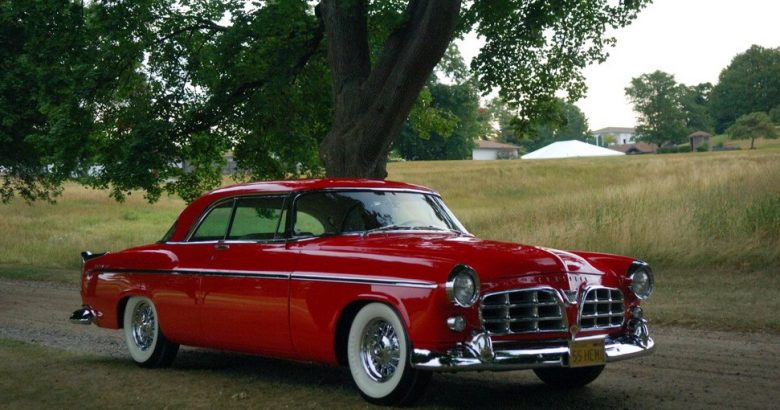
In 1955, Chrysler built a car that was considered one of the first muscle cars. It was called the C-300 because its 331 cu. in. hemi engine developed a true 300HP. It was the first American car to do so.
The C-300s were limited edition cars performance cars. They were offered only a select number of colors and trim, and only in two door hardtops or convertibles. The C-300 could be ordered with a stick shift transmission in certain model years but most owners seemed to prefer the 2 speed PowerFlite automatic. The stock suspension was extra firm which allowed the car to sit lower and corner far better than most standard cars. Owners of the C-300 could choose other premium options, such as “Natural Cowhide” leather upholstery, bright chrome wire wheels and a fully-loaded instrumentation panel.
The C-300 was designed by Virgil Exner, a famous automobile stylist, and was the first example of Chrysler’s new “Fast Look.” The Fast Look design was unusually simple for the times. It was a simple design with little chrome, a lowered the roofline and an aggressive look. The journalists of the day commented that the illusion portrayed by the Fast Look Chryslers was of “fast, forward movement.” The Forward Look was a design style that distinguished the Chrysler line through the 1950s. At $4,110, the new C-300 was the second most costly Chrysler car.
As a result of the powerful hemi engine, the C-300 quickly found itself on the nation’s race tracks. Well known car racer Tim Flock raced the C-300 at Daytona in 1955, winning both the “road course” and the “flying mile.” The 1956 model won both events that year as well. In fact, the Chrysler C-300s dominated all the NASCAR tracks during 1955 and 1956 seasons. Lakeland Chrysler of Greenville, PA, a Chrysler, Dodge, Jeep, Ram dealer says there was actually a movement to ban the C-300 from NASCAR events because the power to weight ratio was so high that it represented “unfair competition.”
Some buyers were less than thrilled about the performance aspects of the C-300. The camshaft was tuned for high horsepower, causing a rather rough idle. The exhaust was free-flow and had a throaty rumble to it. Perhaps the most obvious characteristic, though, was the ride of the C-300. No question, it had a stiffness to it as befits any vehicle with a performance pedigree. For those buyers who wanted a family-hauler, the C-300 was a little too rough around the edges.
In 1959, Chrysler moved away from the hemi engines and replaced the 331 with a 350 cu. in. wedge head design. It developed a healthy 340 horsepower and was far cheaper for Chrysler to produce than the hemi engines. For 1960, the wedge style engine was equipped with the unique and exotic cross-ram carburetor induction system. This new arrangement provided higher torque at lower speeds due to the ram air effect.
The C-300 was built through 1965 when Chrysler retired the name. In all, there were 14,268 hardtops and 2,588 convertibles C-300s produced, not large volume for 11 years of production. The C-300 established a great engineering tradition that continues on in Chrysler Corporation today.
Image Source: conceptcarz.com